Fermenting Beer with Wyeast 1388 Belgian Strong Ale Yeast
Published: October 4, 2025 at 12:22:21 PM UTC
This guide delves into the use of Wyeast 1388 Belgian Strong Ale Yeast for home brewing. It's renowned for its high alcohol tolerance and the production of complex esters and subtle phenolics. These characteristics help beers reach the quality of commercial examples like Duvel, while maintaining a robust malt character.
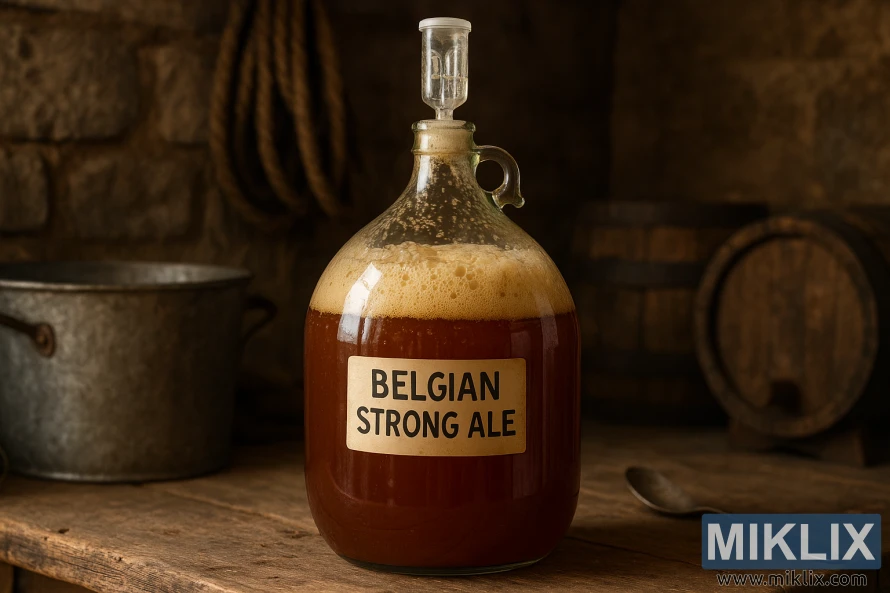
For homebrewers, this guide offers practical advice. It covers strain specs, fermentation management, and the importance of pitching and oxygenation. It also discusses nutrient use and troubleshooting. The aim is to provide a clear, step-by-step resource for both novice and seasoned brewers to achieve consistent Belgian ale fermentation with Wyeast 1388.
The article compares Wyeast 1388 to Duvel yeast, providing insights into achieving dry, slightly tart finishes. It also offers recipe-building tips for Belgian golden and strong styles. Readers can expect hands-on advice on starters, temperature control, and finishing techniques. These methods help preserve complex flavors while ensuring high attenuation.
Key Takeaways
- Wyeast 1388 Belgian Strong Ale Yeast is alcohol tolerant and produces complex esters with subtle phenolics.
- Proper pitching rate and oxygenation are critical when fermenting Belgian strong ale to avoid stalled fermentations.
- Temperature control helps balance fruity esters and phenolic spice typical of Belgian ale fermentation.
- Wyeast 1388 can yield profiles similar to Duvel when matched with the right malt bill and process.
- This guide covers practical steps from buying and storing packs to troubleshooting off-flavors and conditioning.
Overview of Wyeast 1388 Belgian Strong Ale Yeast
The Wyeast 1388 yeast is celebrated for its role in crafting strong golden ales. It's cherished by brewers for its ability to create complex flavors. These include peppery notes and citrus-pear esters, perfect for Belgian Blond, Tripel, and Belgian Golden Strong Ales.
Belgian Strong Ales, with their unique characteristics, are a hallmark of this yeast. It ferments well between 64–80° F (18–27° C) and can handle alcohol levels up to 12–13% ABV. It's ideal for styles like Belgian Specialty Ale and Bière de Garde. Its lineage is traced back to renowned Belgian breweries, including Duvel Moortgat.
Understanding yeast attenuation and flocculation is key to working with Wyeast 1388. It typically attenuates between 74–78%, resulting in a drier beer. Its low flocculation means beers will clear slowly, often requiring time or conditioning to achieve clarity.
For homebrewers in the United States, purchasing Wyeast 1388 is straightforward. It's available from major homebrew retailers, accompanied by product Q&A, customer reviews, and shipping promotions. These resources ensure a smooth purchase process, whether buying starter packs or slants.
When brewing with Wyeast 1388, be prepared for a potentially slow start. Ensure proper oxygenation and healthy pitching rates. Also, allow for extended conditioning to facilitate the yeast's settling. These considerations are essential for achieving the desired ester profiles and steady attenuation in high-gravity Belgian recipes.
Why Choose Wyeast 1388 for Belgian Strong Ales
Wyeast 1388 stands out for those aiming at the classic strong golden and tripel profiles. It offers a complex ester mix with orange and lemon notes, complemented by a subtle peppery phenolic spice. This balance ensures malt presence, even with high attenuation, resulting in a dry, slightly tart finish. It's ideal for Belgian styles.
Its popularity stems from its exceptional flavor and performance. Expect 74–78% attenuation and an alcohol tolerance near 12–13% ABV. This makes it perfect for original gravities above 1.070 and strong goldens aiming for 8–10% ABV. It does so without sacrificing aromatic complexity.
Brewers often seek the best yeast for bright, effervescent Belgian ales. For many, the choice comes down to proven lineage and predictable character. Wyeast 1388, tracing back to Duvel Moortgat, offers refined esters and restrained phenolics. These traits highlight noble hopping and clean sugar profiles.
Practical considerations are key for homebrewers in the United States. Wyeast 1388 is widely available and highly regarded in brewing forums. Its accessibility, along with vendor support and consistent community feedback, solidifies its status as a top choice. It provides reliable results and the specific Duvel-style yeast benefits brewers seek.
Here are some key points to consider when choosing this strain:
- Flavor: bright citrus esters with peppery phenolics.
- Performance: high attenuation and 12–13% alcohol tolerance.
- Suitability: ideal for tripels and strong goldens, making it a top recommendation.
- Availability: easily sourced through major homebrew suppliers in the U.S.
Understanding Belgian Yeast Character and Flavor Contributions
Belgian yeast character is defined by esters and phenolics. Esters contribute fruity notes such as pear, plum, citrus, banana, and floral aromas. Phenolics, when balanced, impart spicy, clove, or black-pepper-like traits.
Wyeast 1388 combines spicy phenolics with clean citrus esters. At moderate temperatures, it highlights lemon and orange with a peppery undertone. Hot fermentation can shift the flavor towards banana esters.
Not all phenolics are desirable. The good ones add spice and complexity. The bad ones smell medicinal, plastic-like, or smoky, clashing with malt and hops.
Brewers see yeast selection and fermentation management as key to shaping flavors. The choice between a strong golden, tripel, dubbel, or dark strong ale hinges on how esters and phenolics complement malt, hops, and spices.
- Pitch rate: higher rates tame ester production; lower rates can boost complexity.
- Oxygenation: adequate oxygen supports clean attenuation and limits harsh fusels.
- Fermentation temperature: cooler temps favor restrained esters; warmer temps increase fruitiness.
- Original gravity and simple sugars: heavy worts and added sugars affect ester balance and solvent risk.
- Nutrients: proper nitrogen and vitamins help robust, controlled fermentation.
By adjusting these control knobs, brewers can coax the desired profile from Wyeast 1388. With careful management, they can achieve layered yeast-driven flavors without harsh fusels or solvent notes that can ruin a beer.
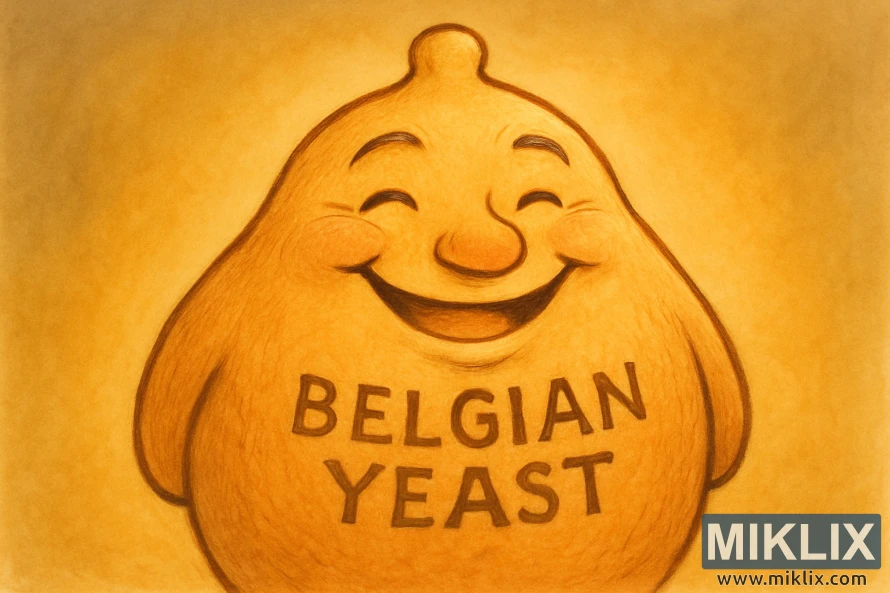
Pitching Rate Recommendations for Strong Belgian Ales
Pitching rate is critical for strong Belgian ales. Aiming for 0.5–1.0 million cells per mL per degree Plato is a good starting point. George Fix and supplier charts suggest 0.75–1.0 million cells per mL per degree Plato for ales.
For a 5-gallon batch, the cell count needed varies with the original gravity. For moderate OGs, around 165 billion cells are recommended. High-gravity beers might require up to 400 billion cells. An OG of 1.080 typically needs about 284 billion cells, a practical middle ground.
To achieve these cell counts, size your yeast starter Wyeast 1388 appropriately. A 0.75 gallon (2.8 L) starter from a Wyeast Activator XL pack can suffice for a 1.080 OG. This is possible with vigorous oxygenation and proper aeration of the wort.
Underpitching can lead to issues like excessive esters and higher fusel alcohols. It also causes sluggish sugar uptake and can result in lingering diacetyl or acetaldehyde. Overpitching, on the other hand, can mute the ale's ester and phenolic character. Adjust your target based on whether you prefer more ester expression or a cleaner fermentation.
- Use a starter or multiple packs for high-gravity brews.
- Measure estimated cell counts before pitching when possible.
- Favor moderate starter growth to avoid stressed yeast that produce off-flavors.
Adhere to supplier notes from Wyeast and literature values for cell counts per mL Plato. This approach keeps expectations realistic and enhances fermentation reliability for Belgian strong ales brewed with Wyeast 1388.
Oxygenation and Aeration Strategies for High-Gravity Worts
Yeast requires oxygen early in fermentation to develop sterols and healthy membranes. Without sufficient oxygen, fermentations can slow, leading to excess esters and fusel alcohols. For high-gravity Belgian ales, pre-pitch oxygenation is critical.
For strong beers, target dissolved oxygen levels are higher. Greg Doss at Wyeast suggests 8–15 ppm O2 for robust yeast performance. For Belgian styles, aim for 12–15 ppm to ensure Wyeast 1388 can attenuate cleanly and develop desired flavors.
Reaching these targets is challenging in warm, high-gravity worts. Oxygen solubility decreases with temperature and gravity. Manual splashing or vigorous shaking can only reach about 8 ppm dissolved oxygen, which may be insufficient for very strong worts.
Using pure oxygen with an oxygen stone setup is the practical solution for pros. A 0.5 micron diffusion stone with regulated pure oxygen can achieve 12–15 ppm in 60–90 seconds. This method creates fine bubbles for rapid transfer without excessive foaming.
- Measure DO when possible. Hand-held DO meters give confidence that you hit target dissolved oxygen ppm Belgian ales before pitching.
- Use caution with flow rates. Low-pressure, short bursts with an oxygen stone pure oxygen keep wort aeration safe and efficient.
- Aerate starters well. Proper oxygenation for strong ales starts in the starter so the yeast builds sterols and reproduces before exposure to high-gravity wort.
Plan oxygenation timing around cooling and yeast pitching. Aerate when wort is at pitching temperature to avoid oxygen loss. When pure oxygen is not available, consider larger starters and multiple pitches to compensate for lower dissolved oxygen levels.
Fermentation Temperature Control with Wyeast 1388
Wyeast 1388 fermentation ranges from 64–80° F (18–27° C). Brewers often start Belgian ales at 68–72° F (20–22° C). This balance ensures a smooth finish while maintaining ester and phenolic character.
Fermentation is a heat-producing process. It can raise the temperature by up to 8° F (4.4° C). It's important to monitor both headspace and wort temperature to avoid exceeding the upper range unintentionally.
Temperature significantly influences flavor. Warmer temperatures enhance esters, potentially introducing banana-like notes. Cooler temperatures, on the other hand, suppress these compounds but may slow fermentation. Wyeast 1388 tends to produce a more estery profile when fermented at higher temperatures.
Decide on a fermentation approach based on your desired outcome. For precise control, use a heat/cool chamber, a temperature-controlled fridge, or a water bath. A short free rise fermentation period can add complexity to the beer.
Practical pitch-rate tips are essential for temperature control. Pitching a larger yeast starter or using multiple packs allows for warmer fermentation without harsh fusels. Underpitching requires cooler temperatures to prevent excessive esters and solvent-like off-flavors.
- Start 68–72° F (20–22° C) for balanced Belgian character.
- Expect a +6–8° F rise from fermentation heat; plan cooling correspondingly.
- Use free rise fermentation sparingly to enhance esters, then cap temps to finish clean.
- Adjust target temps based on pitch rate and desired ester level.
Regularly record both fermenter and ambient temperatures. Small adjustments in the first three days have the greatest impact on the final profile. Consistent control is key to achieving reliable results with temperature-controlled Belgian ales and maximizing the benefits of fermentation temperature with Wyeast 1388.
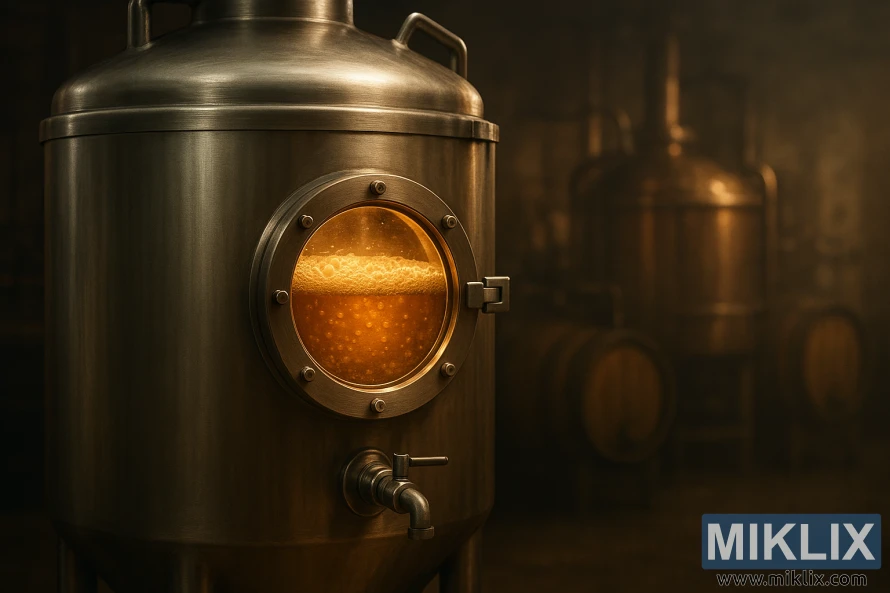
Dealing with Stalled Fermentations and Slow Finishes
Wyeast 1388 can be slow to start and prone to a stalled fermentation Wyeast 1388, often pausing near common gravities. Brewers frequently report a hang around fermentation stuck at 1.035. This pause does not always mean the yeast is dead.
First, confirm a true stall by taking gravity readings over three days. If readings hold steady, try gentle fixes before repitching. Warm the fermenter a few degrees within the yeast's safe range. Rouse the yeast by swirling the fermenter or gently stirring with sanitized equipment.
Minor aeration early in a stall can encourage finish Belgian ales without damaging aroma. Injecting a small, controlled oxygen pulse or giving a brief, careful shake restores yeast vitality. Avoid large oxygen additions late in fermentation to prevent oxidation.
Racking off heavy trub sometimes helps yeast recover their activity. Transfer the beer to a clean carboy and leave most trub behind. This move can reduce stress from autolysis and free yeast to finish fermenting.
- Check pitch rate and starter health; low yeast pitch often causes stalls.
- Ensure adequate oxygen at pitching; target 12–15 ppm for high-gravity worts.
- Add a balanced yeast nutrient if free amino nitrogen seems low.
If simple measures fail, add an active starter of a compatible Belgian strain or a fresh Wyeast 1388 pack to nudge fermentation. Pitch the starter slowly and keep temperatures steady to avoid shocking the culture.
Prevent future stalls with proper planning: correct pitching rates, measured oxygenation, consistent temperatures, and nutrient dosing. These steps reduce the chance of a stalled fermentation Wyeast 1388 and make an encouraging finish Belgian ales more likely.
When troubleshooting, document gravity changes and interventions. That record helps identify patterns and prevent a repeat of fermentation stuck at 1.035 in subsequent batches.
Nutrient Use and Yeast Health for Alcohol Tolerant Strains
Strong Belgian worts require more from yeast than regular beers. A quality yeast nutrient for Belgian ales is essential. It provides vitamins, minerals, and amino acids for robust growth and clean attenuation.
Creating a well-sized starter and ensuring proper oxygenation before pitching is key. This approach reduces stress on the yeast and minimizes harsh fusel alcohols in high-alcohol fermentations.
- Use Servomyces or similar products when making the starter to boost yeast vitality.
- Add a nutrient for high-gravity fermentation early in the active phase, not late, to ensure uptake.
- Consider staggered nutrient additions for very high original gravities to maintain cell function as alcohol rises.
Wyeast 1388 can handle about 12–13% ABV in many batches. As alcohol approaches this level, yeast health declines, and fermentation slows. Proper nutrients, controlled temperatures, and adequate oxygen are vital for sustained activity through the finish.
Follow the manufacturer's dosing guides for Servomyces and other energizers. Avoid overfeeding late in fermentation. Good sanitation, consistent temperature control, and measured oxygenation are essential for alcohol-tolerant strains to thrive.
Recipe Building Tips Using Wyeast 1388
Begin with a clean base grain for strong goldens and tripels. Belgian Pilsner malt serves as a neutral backbone. For dubbels or strong dark ales, add Special B or Caramunich sparingly. This avoids masking the yeast character.
For tripels, keep specialty malts light. A small amount of Carapils enhances head retention without darkening the color. This approach supports the goals of building a Belgian strong ale recipe while highlighting the yeast.
Introduce simple sugars late in the boil to boost attenuation and lighten the body. Candi sugar or corn sugar added late raises the ABV and dries the finish. Monitor how these sugar adjuncts in tripels affect ester and phenol balance during development.
Set a target gravity and expect Wyeast 1388 to attenuate in the 74–78% range. For a strong golden, aim for an OG of 1.080 and an FG of 1.015. This will result in an ABV of roughly 8.5–9%. These numbers guide yeast handling and nutrient planning.
Match hopping to yeast-driven flavors. Aim for moderate bitterness, about 35–45 IBU, to keep balance without suppressing phenolics. Choose floral and spicy European varieties like Perle and Saaz to complement Wyeast 1388.
- Grain bill example: Belgian Pilsner 85–90%, Carapils 5%, Special B 2–5% for color tweaks.
- Sugar adjuncts: 1–1.5 lb of candi or corn sugar for a 5-gallon tripel recipe to reach target OG and dryness.
- Mash profile: 148–152°F for moderate body, or 150°F for a slightly fuller mouthfeel.
Follow a simple sample formula when building Belgian strong ale recipe drafts. Use the grain percentages above, add sugar adjuncts in tripels late in the boil, and plan hops for aromatic support. Avoid assertive bitterness.
Refer to proven recipes like Mike’s “Devilish” Belgian Strong Golden as a template. This style often lists OG 1.080, FG 1.015, Belgian Pilsner malt, Carapils, about 1.3 lb corn sugar, Perle and Saaz hops, and Wyeast 1388. Mash at 150°F for 90 minutes and ferment near 68°F for clean results.
Adjust yeast pitch and oxygenation for high gravity worts. A healthy starter and attention to nutrient levels reduce stress on Wyeast 1388. Small recipe tweaks preserve yeast esters while achieving desired ABV.
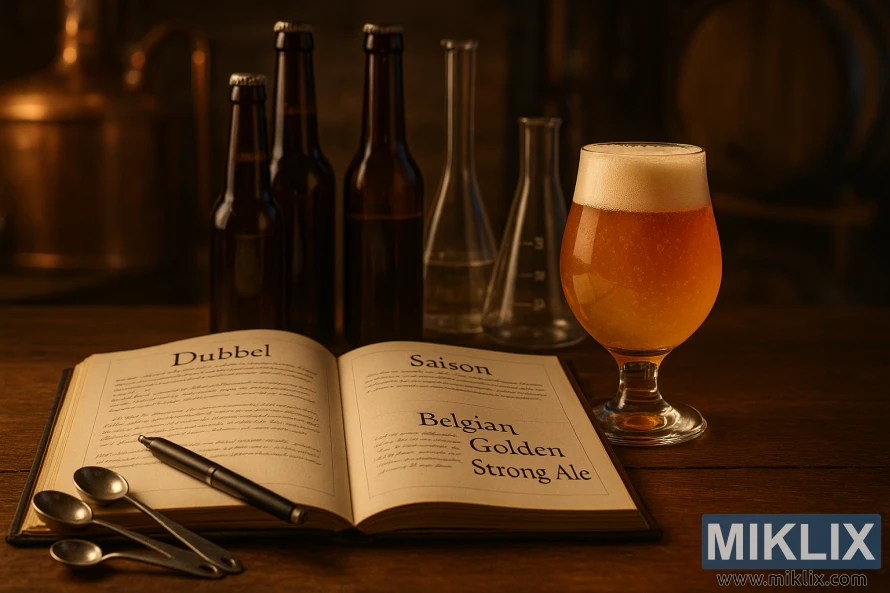
Practical Fermentation Schedules and Conditioning
Begin with a detailed plan for your fermentation schedule Belgian strong ale. For Wyeast 1388, aim for about 10 days of primary fermentation at roughly 68°F (19°C). Check gravity after day seven and again at day ten to confirm active fermentation is slowing.
Implement a gentle temperature ramp from 68–72°F if the wort stalls or needs a push. A controlled rise of a few degrees over several days helps yeast finish without producing harsh phenols. Avoid sudden large swings that stress the yeast.
Plan secondary fermentation times to suit clarity and flavor goals. Moving the beer off trub after primary can reduce risk of a stuck finish near 1.035 and speed clearing. Typical secondary fermentation times in many recipes are two weeks, with longer aging for stronger or darker profiles.
Conditioning Belgian ales benefits from patience. Strong blond and tripel styles often need only a few weeks in secondary plus a month or two of bottle or keg conditioning. Strong dark ales gain complexity with several months of aging. Match conditioning length to desired smoothness and attenuation.
Carbonation and packaging depend on stable final gravity. Verify a steady FG across three days before priming. Proper conditioning reduces the chance of over-carbonation in bottles. Use style-appropriate volumes of CO2 for the target beer.
Monitor fermentation with regular gravity readings and sensory checks. Belgian strains can be slow but reward brewers with layered spice and fruit notes when given time and a thoughtful schedule. Keep notes so you can refine future fermentation schedule Belgian strong ale plans and optimize secondary fermentation times for each recipe.
Comparing Wyeast 1388 to Other Belgian Strains
Wyeast 1388 is known for its peppery notes and clean citrus esters. It's chosen for creating a Duvel-like, bright golden ale. This ale finishes dry, without the heavy fruity complexity often found in other styles.
When comparing WLP570, many brewers find similar results to Wyeast 1388. White Labs WLP570 can replicate the 1388 profile. Yet, slight variations between labs can impact ester balance and attenuation.
Other Belgian strains offer a different flavor profile. Wyeast 3522 and White Labs WLP550 are geared towards spicy, complex flavors. These are ideal for amber and darker Belgian beers. Wyeast 3787 and WLP530, linked to Westmalle, enhance ester production, benefiting many tripels.
Wyeast 1214, known for its Chimay characteristics, produces richer ester tones. These are perfect for dubbels and some tripels. This strain often brings deeper fruitiness and layered complexity compared to 1388.
- Choose Wyeast 1388 for clean, spicy golden ales and many tripel styles.
- Pick WLP570 when you want a similar Duvel-like profile from another house.
- Opt for Wyeast 3522, 3787, or 1214 when targeting Trappist-like complexity or stronger fruit esters.
Fermentation temperature, pitch rate, and oxygenation significantly influence yeast expression. Small adjustments can make Wyeast 1388 sound more ester-forward or phenolic. The same applies to WLP570 and the Wyeast 3522 3787 1214 group.
When choosing a yeast, align strain characteristics with your recipe goals. Use 1388 for a balanced spice profile. For pronounced fruitiness or classic Trappist character, opt for other Belgian strains.
Equipment and Sanitation Considerations for Strong Ales
For brewing Belgian strong ales, it's essential to use reliable equipment. A wort chiller that can cool large volumes quickly is necessary. A wort pump is also useful for moving hot beer. Fermentation vessels should have extra headspace for vigorous activity.
Choose vessels made of Glass or stainless steel. These materials handle repeated cleaning well and provide clear sight of krausen development.
Oxygenation equipment is vital for a healthy start. An oxygen tank with a diffusion stone can quickly reach the target dissolved oxygen level. Aim for 12–15 ppm for high-gravity worts. A quality hydrometer or digital refractometer is essential for tracking attenuation and pitching strength.
A stir plate and Erlenmeyer flask are useful for building yeast starters. This ensures the needed cell counts for fermentation.
- Temperature control gear: fermentation chamber or temperature controller, and a water bath for small batches.
- Sanitation supplies: no-rinse sanitizers, PBW or OxiClean for cleaning, and dedicated brushes for mash tuns and fermenters.
- Packaging gear: pressure-rated kegs, bottles rated for higher carbonation, and pressure-safe conditioning vessels.
Sanitation is key when brewing strong ales. Remove hop and grain debris from the mash tun and boil kettle. Clean fermenters thoroughly, then sanitize just before transfer.
Pay attention to trub management during racking. This reduces stress on yeast and the risk of stalled fermentations or off-flavors.
Handling high-gravity wort requires robust cooling and measured oxygenation equipment. Rapid chill reduces the chance of DMS and allows timely aeration. Oxygenate immediately after chilling, then pitch a healthy starter.
Track fermentation with a hydrometer and keep temperatures steady. This protects delicate Belgian esters.
- Prepare yeast starters using a flask and stir plate or use commercially prepared starters from White Labs and Wyeast.
- Use oxygenation equipment to reach target DO before pitching.
- Maintain sanitation with no-rinse sanitizer at all transfer points.
- Use conditioning vessels and check carbonation ratings before packaging.
When buying supplies, check vendor policies from Northern Brewer, MoreBeer, or Brewers Supply Group. Read customer reviews and warranty details. Look for free shipping thresholds if ordering heavy gear like oxygen tanks or large fermenters.
Consistent investment in the right equipment and disciplined sanitation will protect your batch. Proper tools reduce risk and support clean, robust fermentation for strong ales.
Troubleshooting Common Off-Flavors with Belgian Yeasts
Belgian ales can exhibit a variety of faults. Identifying each off-note is essential for selecting the appropriate solution. Common issues include excessive esters, solvent-like notes, buttery diacetyl, and green apple acetaldehyde.
Excessive esters or banana aromas often stem from high fermentation temperatures or low pitch rates. To address this, reduce fermentation temperatures and increase the pitch rate when feasible. If active yeast is available, re-pitching healthy Saccharomyces can correct a stuck ester profile.
Solvent fusel alcohols produce hot, harsh flavors and burning notes. These issues typically arise from underpitching, high temperatures, or stressed yeast. To mitigate this, cool the fermenter, oxygenate the new wort to 12–15 ppm DO, and provide nutrients to support yeast recovery.
Diacetyl, which smells like butter or butterscotch, often occurs when yeast finish fermentation too early or are stressed. To resolve this, allow the beer to rest slightly warmer toward the end of fermentation to enable yeast to reabsorb diacetyl. If the problem persists, re-pitch a vigorous strain for cleanup.
Acetaldehyde, which imparts a green apple note, indicates incomplete fermentation. Ensure proper attenuation by increasing the pitch rate, providing adequate oxygen at pitch, and allowing more time at stable temperatures for yeast to finish.
- Medicinal or smoky phenolics usually signify contamination or incorrect yeast selection. Verify sanitation and confirm the strain matches the recipe.
- Prevent off-flavors by ensuring correct pitching, maintaining 12–15 ppm DO for Belgian ales, and timely nutrient additions.
- Condition patiently; many faults diminish with time as yeast refine flavors during maturation.
When corrective measures fail, re-pitching healthy yeast or adjusting temperature often proves effective. Use activated carbon filtering only as a last resort for severe faults that cannot be corrected biologically.
Keep detailed logs of pitch rates, oxygenation levels, and temperatures. Accurate records facilitate tracing causes and reducing repeat problems related to off-flavors in Belgian ales, solvent fusel alcohols, and diacetyl acetaldehyde in Belgian beers.
Recipe Examples and Proven Mash/Boil Procedures
Below are two tested recipes and clear steps for mash and boil work. They pair well with a mash schedule Wyeast 1388 and a careful boil procedure Belgian tripel. Each example lists grain, hops, sugars, and practical notes for brewers aiming for clean fermentation and rich Belgian character.
Example 1 — Mike’s “Devilish” Belgian Strong Golden (5 gal):
- Target: OG 1.080, FG 1.015, IBU 40, SRM 3–5, ABV 8.6%.
- Grain: 14.7 lb Belgian Pilsner, 0.35 lb Carapils.
- Sugar: 1.3 lb granulated corn sugar added last 15 minutes of the boil.
- Hops: German Perle at 60 minutes (bittering), Czech Saaz at 10 and 0 minutes (aroma).
- Yeast: Wyeast 1388; pitch a healthy starter sized to gravity.
Mash this batch at 150°F (66°C) for 90 minutes. This maximizes attenuation and creates a light body suitable for the style. The mash schedule Wyeast 1388 supports good ester development while leaving enough fermentables for a higher ABV.
Boil 75 minutes with hop additions at the scheduled times. Add the corn sugar with 15 minutes left. Use a rapid chill, rack off trub if desired, then oxygenate to 12–15 ppm dissolved oxygen before pitching.
Ferment at 68°F for 10 days primary, then move to secondary for two weeks. This allows for conditioning and clarification. Monitor gravity to confirm a steady finish.
Example 2 — Dixie Cup Boardwalk Belgian Quadrupel (5 gal):
- Target: OG 1.090, FG 1.020, IBU 30, SRM 15–17, ABV 9.3%.
- Grain bill: Belgian Pilsner, aromatic malt, Munich, CaraMunich, Special B, small touch of chocolate malt.
- Sugars: Belgian dark candi and turbinado added during the boil; optional fruit or spices added late.
- Hops: Keep bitterness moderate to let malt and sugar shine.
- Yeast: Wyeast 1388; use a larger starter and consider step feeding for high gravity.
For this recipe, use a full-mash program with rests targeted to specialty malts. Include conversion rests for Munich and caramel malts to extract sugars and build color. Adjust time and temperature to taste and to match the chosen specialty malts.
Adopt a boil procedure Belgian tripel that allows for complete incorporation of candi and turbinado sugars. A 60–90 minute boil works well; a longer boil helps darken color slightly and develops deeper sugar flavors without adding unwanted harshness.
Procedural notes applicable to both examples:
- Chill wort rapidly to yeast pitching temperature to limit DMS and oxidation.
- Rack off heavy trub if you prefer a cleaner start for the yeast.
- Oxygenate wort to the recommended DO before pitching; for high gravity worts aim for 12–15 ppm.
- Pitch a healthy starter sized for the gravity and follow the fermentation schedule described above.
These recipe examples balance grain, sugar, and yeast choices so a brewer can replicate classic Belgian profiles. Use the mash schedule Wyeast 1388 and a controlled boil procedure Belgian tripel approach to bring out the right esters and finish for each Belgian strong ale recipe.
Buying, Handling, and Storing Wyeast 1388 Packs
When purchasing Wyeast 1388, opt for trusted homebrew retailers like Northern Brewer, MoreBeer, or your local shop. Product pages detail batch dates, reviews, and shipping information, highlighting seller reliability. Look for recent production dates and cold-shipping notes to ensure yeast viability.
Proper Wyeast pack handling is critical from the moment it arrives. Inspect the sachet for swelling or damage and store it in the refrigerator until activation. Adhere to the manufacturer's instructions for optimal results.
For large or high-gravity batches, consider purchasing multiple packs or a Wyeast Activator XL. An Activator XL offers additional nutrient and oxygen support for bigger starters.
Prepare a starter that reaches the recommended cell counts for strong Belgian ales. Use clean glassware, aerate well, and let it finish before decanting and pitching. Healthy starters reduce fermentation lag and off-flavors.
- Store liquid yeast cold, ideally between 34°F and 40°F, and use it before the expiration date.
- Avoid temperature swings while storing liquid yeast to prevent stress on the culture.
- If shipping includes a warm transit, prioritize packs that were shipped cold and arrive quickly.
Effective Wyeast pack handling includes clear labeling of purchase date and batch number. Track seller shipping policies and satisfaction guarantees for returns or replacements if viability is compromised during transit.
Adhering to these steps ensures yeast performance and consistent results when brewing Belgian strong ales with Wyeast 1388.
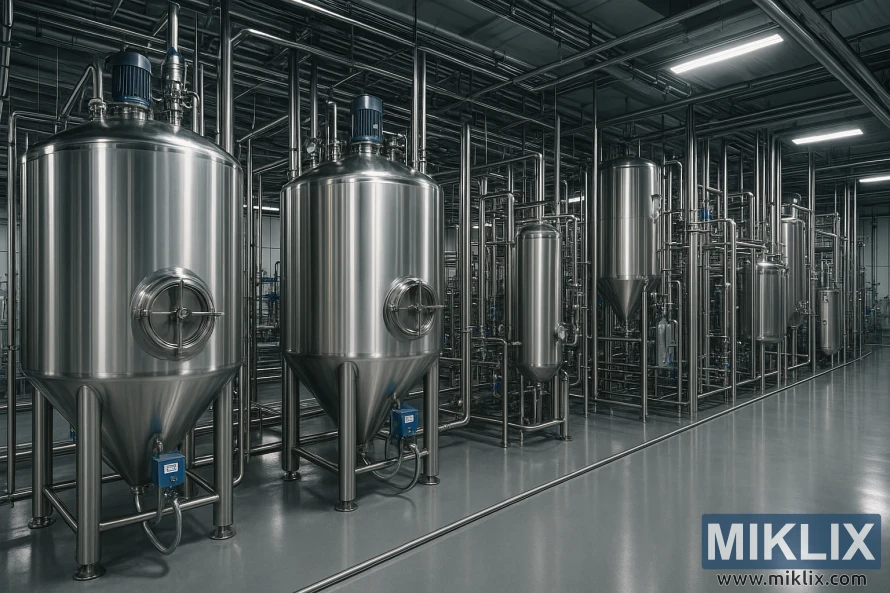
Conclusion
Wyeast 1388 summary: This strain excels in brewing Duvel-style strong goldens and tripels. It offers complex esters and peppery phenolics. It also achieves high attenuation, around 74–78%, and can handle alcohol levels up to 12–13% ABV. These characteristics bring a classic Belgian flavor to your brew, provided you match the yeast's profile with your recipe and fermentation techniques.
When brewing Belgian strong ales, practical steps are key. Start with a suitable-sized starter and ensure proper oxygenation of high-gravity worts. Use pure oxygen and a diffusion stone to achieve 12–15 ppm. Also, provide yeast nutrients to support alcohol-tolerant cells. It's vital to control fermentation temperature and avoid finishing near 1.035 to prevent stalls.
Adopt tested mash and conditioning practices. For instance, a single infusion mash at 150°F for 90 minutes and an extended conditioning period can balance esters, attenuation, and body. Remember, equipment and sanitation are critical to maintaining fermentation health and flavor clarity.
Final thoughts Wyeast 1388: For U.S. homebrewers aiming for authentic Belgian strong ales, this strain is a top choice. It requires careful pitching rates, oxygenation strategy, nutrient management, and patient conditioning. Employ proven recipes and meticulous fermentation control to fully exploit Wyeast 1388's strengths.
Further Reading
If you enjoyed this post, you may also like these suggestions:
- Fermenting Beer with CellarScience Hornindal Yeast
- Fermenting Beer with Wyeast 3726 Farmhouse Ale Yeast
- Fermenting Beer with Mangrove Jack's M36 Liberty Bell Ale Yeast
